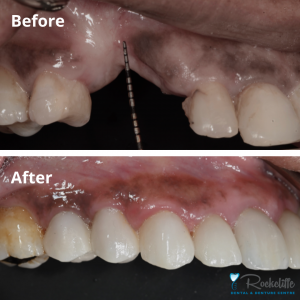Dental implants are becoming one of the most popular ways for replacing missing teeth. In fact, they may be preferable to other alternatives such as a partial denture or a bridge.
However, the dental implant procedure requires thorough consideration and evaluation, especially with regards to the condition of the bone where the implant is to be placed. This is where dental bone grafting in Ottawa comes into play.
What is a Dental Bone Graft?
Dental bone grafting is a surgical procedure that regenerates and replaces lost bone and can even restore the right face contour.
If you have lost your teeth due to trauma, injury, or decay, bone loss will occur over time, and the jawbone will begin to deteriorate. In this case, a bone graft surgery will be performed to create a more solid base for an implant.
Why Worry About Bone for Dental Implants?
A dental implant presents a metal post screwed into a jawbone, which is used as an anchor holding an artificial tooth crown.
When the implant is placed, it is important to ensure that enough bone growth has occurred. The metal posts need to be fully osseointegrated and stable enough to serve as artificial tooth roots to support dental crowns. The implant dentist in Ottawa must take great care to make sure that there is adequate bone volume to provide the dental implant with its stability and strength.
As such, when placing a dental implant, the dentist needs to make sure that there is enough bone around it in all dimensions: width, height, and depth.
How Much Bone is Needed Around a Dental Implant?
Generally, a minimum of 1mm of bone is needed around a dental implant. If the implant is next to another implant, more space is required. If there is not enough healthy bone structure around the implant, a bone graft treatment may be performed.
When evaluating the height of the bone, it’s important to have just enough bone to have the implant completely submerged. However, the implant should never go deep enough to impinge on other anatomic structures such as the sinus in the upper jaw or the nerve in the bottom jaw.
Many times, when placing an implant in the upper jaw, there may not be enough space vertically. Then, a sinus lift will be performed to rebuild the bone.
Bone Graft Surgery
 Traditionally, dental bone grafting involved removing a part of the bone from another part of the body and transplanting it into the jawbone to support bone formation. Today, there are easier alternatives, such as obtaining replacement bone from an animal or cadaver source. These options prevent a second surgical site and provide less morbidity to the patient.
Traditionally, dental bone grafting involved removing a part of the bone from another part of the body and transplanting it into the jawbone to support bone formation. Today, there are easier alternatives, such as obtaining replacement bone from an animal or cadaver source. These options prevent a second surgical site and provide less morbidity to the patient.
After the bone grafting surgery, it may take several months for the transplanted bone to grow a sufficient amount of new bone to support the placement of a dental implant.
After the jawbone has healed, the implant process can move forward, and the titanium implant can be placed into the jawbone. After a few months of healing, a skilled implant dentist will place the abutment into the jaw, and the tooth crown will be attached to it.
Types of Bone Grafting Procedures
The type of bone grafting you require will depend on the condition of your jaw bone.
- Major bone grafting is needed for individuals with defects of the jaw and significant bone defects due to trauma. This involves extracting bone tissue from elsewhere in the body, such as hips, legs, or a scull. This procedure is performed under general anesthesia and requires the patient to stay in the hospital.
- Minor bone grafting for dental implant placement is a minor surgical procedure performed during an in-office visit.
The minor type of graft for implants is a lot more common and is performed in our office on a daily basis. The different minor bone graft types include:
1. The Socket Graft
 After extraction of natural teeth or adult tooth loss due to decay or periodontal disease, the body quickly dissolves the surrounding jawbone, unless the tooth is quickly replaced with a socket graft or a dental implant.
After extraction of natural teeth or adult tooth loss due to decay or periodontal disease, the body quickly dissolves the surrounding jawbone, unless the tooth is quickly replaced with a socket graft or a dental implant.
If the dental implant is placed immediately after the tooth extraction, a bone graft may be not required. However, in cases of size variance or infection, a socket graft, also known as “ridge preservation graft”, will be placed instead. This bone graft type is applied directly to the empty space or socket left after the tooth is extracted.
After three to six months of the healing process, the bone graft site will be ready for a dental implant.
2. The Block Bone Graft
If tooth removal is not immediately treated with an extraction socket graft, more significant loss of bone can occur.
Other factors and risks that could lead to lack of bone include:
- Trauma
- Injury
- Severe gum disease
In such cases, a block bone graft is used to reconstruct the jawbone. This procedure involves either your own piece of bone from the back of the lower jaw or the chin or, more commonly, a cadaver or donor block bone graft.
After a few months, once the bone graft fuses with the alveolar bone, the dental implant process can continue.
3. The Sinus Lift Procedure
Placing an implant in the upper jaw is often complicated due to the proximity to the sinus. In this location, there is very little bone between your mouth and your sinus cavity, so, prior to placing an implant, a sinus lift procedure may be necessary.
A sinus lift procedure shifts your maxillary sinus slightly upward, so that bone tissue can be implanted in the space directly above the jaw.
Sometimes, the dental implant can be placed immediately after the sinus lift. However, if the natural bone is thin, you might have to way a few months to allow the bone to heal.
Bone Graft for Dental Implant Surgery: FAQ
There are several types of bone graft materials available today:
- Synthetic: a synthetic bone graft substitute from a biocompatible material (artificial bone material)
- Autograft: a portion of bone is taken from somewhere else in the patient’s own body
- Allograft: natural bones from a genetically similar organism (human bone)
- Xenograft: donor tissue or bone from a genetically different organism
The material chosen for a bone graft will depend on your specific situation and on the amount of bone required.
No, they aren’t painful. At Rockcliffe Dental & Denture Centre, we perform bone grafts every day. Dental anesthesia makes the bone graft procedure virtually painless, but we also provide dental sedation options for cases of extreme dental anxiety.
While the bone graft heals, you should not experience any pain or discomfort either. A bone graft is a standard procedure and the first step for most people before they can enjoy their beautiful replacement tooth.
After the procedure, your dentist will prescribe you antibiotics to prevent infection. You may also be prescribed pain medication, but it is usually not required.
Generally, the recovery time can vary between two weeks to two months. The exact timing would depend on the person’s physical health, age, and overall oral health.
If the person is preparing for dental implant surgery, they would have to wait for a few months for the bone graft to fuse with the natural bone.
No, your body cannot reject the bone graft because bone doesn’t contain any living or genetically coded materials. The only possible issue is if your body doesn’t make enough bone in response to the graft.
Yes, a dental bone graft can get infected due to:
- Infected bone grafting material
- Infected dental tools
- Poor after-care
To prevent potential infection, it is crucial to choose a trusted dental clinic and a skilled professional, such as implant dentists at Rockcliffe Dental & Denture Centre. It is also important to take prescribed antibiotics after the procedure, maintain oral hygiene, and carefully follow the after-care instructions.
Rockcliffe Dental & Denture Centre: Your Bone Graft Specialist in Ottawa
Dental implants and bone grafts are serious surgical procedures that should only be performed by a skilled and experienced oral surgeon or implant dentist. While some patients may consider visiting their family dentist for this procedure, this sensitive, multi-stage procedure requires the help of an implant specialist truly proficient in the field.
Luckily, at Rockcliffe Dental & Denture Centre in Ottawa, we have experienced surgeons to conduct the process from the beginning to the end. And while bone grafting and dental implant procedures may take some time, the end result will be well worth it!
Contact us today to learn more about our services.
- Learn more about dental bone graft recovery & aftercare